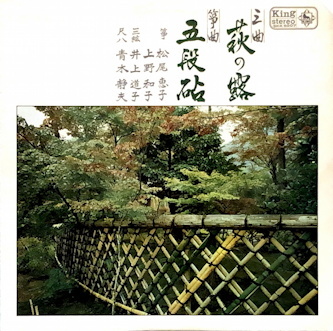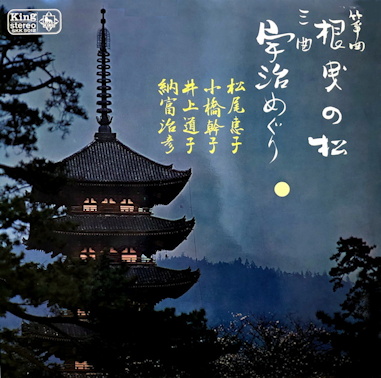Born in Tokyo on September 18, 1916.
Matsuo Keiko studied under Michio Miyagi from the age of six, and entered the Elective Department of the Tokyo School of Music in March 1929, completing the same course in 1933 as the first graduate. She was under the tutelage of Michio Miyagi for many years, and gave numerous performances and recordings together with her sister, Kazuko.
The day after Michio Miyagi came to Tokyo from Korea in 1917, he accompanied shakuhachi player Yoshida Seifū to perform "Water Metamorphosis" at the home of Matsuo Keiko's father, Ueno Hideyoshi,in Tsurumaki-cho, Waseda. Keiko's father, who was a student of Yoshida Seifū, was so shocked by the performance that he immediately invited his aunt and other relatives to become his students, and later went to Miyagi Michio to have him play the piece with Ueno playing shakuhachi. Keiko, who was eight months old at the time, waited until after her sixth birthday, and then, on June 6, which was considered a fortuitous day to do so, enrolled at Miyagi's school. Her younger sister Kazuko also entered the school on June 6, also at the age of six, six years later.
|
|
|
Lehrer
|
 |
Ikuta-Ryū Sōkyoku - Nana Komachi/ Sato no Akatsuki/ Hachidan no Shirabe Three classic ensemble pieces |
 |
Ikuta-Ryū Sōkyoku - Shiki no Nagame/ Sode Kōro/ Sono no Aki Three classic sōkyoku works. |
 |
Ikuta-Ryū Sōkyoku Senshū - volume 4 Four classic Ikuta-style ensemble works. |
 |
Ikuta-Ryū Sōkyoku Senshū - volume 5 Three classic Ikuta-style ensemble pieces. |
 |
Ikuta-Ryū Sōkyoku Senshū - volume 7 Four classic Ikuta-style ensemble pieces |
 |
Ikuta-Ryū Sōkyoku Senshū - volume 9 Two classic ensemble pieces. |
 |
Sankyoku - Hagi no Tsuyu / Sōkyoku - Godan Kinuta Two classic ensemble pieces |
 |
Sō - Shamisen - Shakuhachi ni yoru Mei Senshū A collection of Sōkyoku masterpieces for Koto, Shamisen, and Shakuhachi. |
 |
Sō to Sangen no Shirabe - Sōkyoku to Jiuta Four classic Ikuta-style ensemble pieces. |
 |
Sō-Sangen-Shakuhachi ni yoru Mei Senshū - volume 5 Four classic works for koto, shamisen, and shakuhachi. |
 |
Sōkyoku (Ikuta-Ryū) - Koten no Shirabe volume 10 Five classic ensemble pieces |
 |
Sōkyoku (Ikuta-Ryū) - Koten no Shirabe volume 2 Four classic ensemble works. |
 |
Sōkyoku (Ikuta-Ryū) - Koten no Shirabe volume 5 Ikuta-style pieces featuring Matsuo Keiko. |
 |
Sōkyoku - Koten Meikyoku Sen - Chidori no Kyoku/ Miyama Jishi/ Midare/ Shiki no |
 |
Sōkyoku - Nebiki no Matsu / Sankyoku- Uji Meguri Two classic ensemble pieces |
 |
Sōkyoku - Shin Aoyagi / Kajimakura Two classic Jiuta pieces. |
 |
Zoku Sō-Sangen-Shakuhachi ni yoru Mei Senshū - volume 10 Classic works for koto, shamisen, and shakuhachi. |
 |
Zoku Sō-Sangen-Shakuhachi ni yoru Mei Senshū - volume 2 Four classic ensemble works for koto, shamisen, and shakuhachi. |
 |
Zoku Sō-Sangen-Shakuhachi ni yoru Mei Senshū - volume 3 Four classic ensemble works for koto, shamisen, and shakuhachi. |
 |
Zoku Sō-Sangen-Shakuhachi ni yoru Mei Senshū - volume 4 Four classic ensemble pieces for koto, shamisen, and shakuhachi. |
 |
Zoku Sō-Sangen-Shakuhachi ni yoru Mei Senshū - volume 6 Four classic ensemble pieces for koto, shamisen, and shakuhachi. |
 |
Zoku Sō-Sangen-Shakuhachi ni yoru Mei Senshū - volume 8 Three classic ensemble works for koto, shamisen, and shakuhachi. |
























